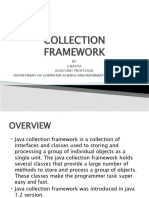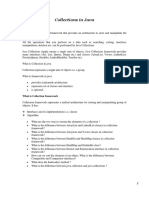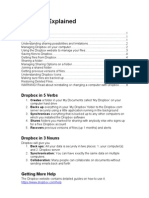0 ratings0% found this document useful (0 votes)
26 viewsLecture 9
The collection framework provides interfaces and classes for storing and manipulating collections of objects. Key interfaces include Collection, List, Queue, and Set. An ArrayList is a commonly used implementation of the List interface that dynamically resizes itself as elements are added or removed. ArrayLists store objects and autobox primitive values. Iterators can be used to loop through and access the elements of a List.
Uploaded by
vlj47633Copyright
© © All Rights Reserved
Available Formats
Download as PDF, TXT or read online on Scribd
0 ratings0% found this document useful (0 votes)
26 viewsLecture 9
The collection framework provides interfaces and classes for storing and manipulating collections of objects. Key interfaces include Collection, List, Queue, and Set. An ArrayList is a commonly used implementation of the List interface that dynamically resizes itself as elements are added or removed. ArrayLists store objects and autobox primitive values. Iterators can be used to loop through and access the elements of a List.
Uploaded by
vlj47633Copyright
© © All Rights Reserved
Available Formats
Download as PDF, TXT or read online on Scribd
You are on page 1/ 13
Collection
• The collection framework is nothing but the
API which contains a number of interfaces and
classes. The important interfaces in this API
are :
1. Collection
2. List
3. Queue
4. Set
Meaning of word “collection”
• In java the word ‘collection’ is overloaded as
follows:
• collection : (with small ‘c’) it is basically refer to
any data structure, which stores the object and
iterate over.
• Collection: (with capital ‘C’) it is basically refer to
java.util.Collection interface.
• Collections: (with capital ‘C’ and s at the end) it is
basically refers to the java.util.Collections class
which contains static utility methods.
Classes of collection API
• The important Classes of collection API are:
• ArrayList is nothing but the class which is used to
store the object dynamically.
• In this we don’t need to mention the length of
the ArrayList, instead of this, it’s length increases
as new objects are added and shrinks when
objects are removed from it.
• ArrayList never stores the ‘primitive values’.
• All values stored in the ArrayList are object, if we
try to add primitive value, it will be implicitly
changes to the objects by “autoboxing”
Wrapping, Unwrapping and Auto boxing
of primitives
• Autoboxing:
Autoboxing is basically a technique in which compiler
automatically wrap and unwrap the primitives in order to store
them in “ARRAYLIST”.
• Wrapping and Unwrapping a integer variable:
• public class Test {
public static void main(String[] args)
{
int i = 45;
Integer wrapper = new Integer(i);
System.out.println(wrapper);
int unwrapped = wrapper.intValue();
System.out.println(unwrapped);
}}
Wrapper classes
• Wrapper classes are those classes, which are
used to ‘wrap’ primitive variables in such a way,
that they behave like an object. These classes are:
1. Integer – for wrapping int value.
2. Character – for wrapping char value.
3. Boolean – for wrapping boolean value.
4. Long – for wrapping long value.
5. Float – for wrapping float value.
6. Double – for wrapping double value
Creating a ArrayList
• An ArrayList is created just like an array,
without mentioning the length of the array :
ArrayList myList = new ArrayList();
Methods of ArrayList
• The important methods of ArrayList are:
1. myList.add() // for adding a object to the
arrayList.
2. myList.remove() // for removing the object
from the arrayList
3. myList.contains() // returns true if the object
is present in the list otherwise false
4. myList.get() // retrieve the object from the
index given in the argument
Method of ArrayList continues
5. myList.isEmpty() // returns true if the list is
empty otherwise false.
6. myList.size() // returns the actual size of the
arrayList.
7. myList.indexOf() // it will show the index of
the object passed in the arguments.
Parameterization of ArrayList
• After Java 5, parameterization of ArrayList is
possible, that is we are allowed to restrict the
ArrayList to store only ‘same’ type of data.
ArrayList<Integer> myList = new
ArrayList<Integer>() // it will store only the
integer values
List
• Lists are usually used to keep things/objects in
some kind of order.
• Lists allow you to manually override the
ordering of elements by adding or removing
elements via the element's index.
• Before Java 5, and the enhanced for loop, the
most common way to examine a List "element
by element" was by the use of an Iterator.
Iterator
• An Iterator is an object that's associated with a specific
collection. It lets you loop through the collection step
by step. The two Iterator methods you need to
understand for are:
■ boolean hasNext() Returns true if there is at least one
more element in the collection being traversed.
Invoking hasNext() does NOT move you to the next
element of the collection.
■ Object next() This method returns the next object in
the collection,
AND moves you forward to the element after the element
just returned.
• public static void main(String[] args)
• {
• ArrayList<Integer> a = new ArrayList<Integer>();
• a.add(23);
• a.add(45);
• a.add(56);
• a.add(67);
• a.add(89);
• Iterator i = a.iterator();
• while(i.hasNext())
• {
• Object element = i.next();
• System.out.println(element);
• }
• }
You might also like
- Tài Liệu Tóm Tắt ISTQB Foundation Level Phiên Bản 2018 Cập Nhật67% (6)Tài Liệu Tóm Tắt ISTQB Foundation Level Phiên Bản 2018 Cập Nhật52 pages
- Tài Liệu Tóm Tắt ISTQB Foundation Level Phiên Bản 2018 Cập Nhật67% (6)Tài Liệu Tóm Tắt ISTQB Foundation Level Phiên Bản 2018 Cập Nhật52 pages
- Topic 2-List (Sequential List) Arraylist Class: Edited by Miss Nafisah AminNo ratings yetTopic 2-List (Sequential List) Arraylist Class: Edited by Miss Nafisah Amin29 pages
- Object Oriented Programming Object Oriented Programming: Lecture-9 Instructor NameNo ratings yetObject Oriented Programming Object Oriented Programming: Lecture-9 Instructor Name18 pages
- BSCS Semester 6 Mcs 3 Course Instructor: Ms. IramNo ratings yetBSCS Semester 6 Mcs 3 Course Instructor: Ms. Iram29 pages
- Java Advanced Features and Programming Techniques (Step-By-Step Java Book 3)No ratings yetJava Advanced Features and Programming Techniques (Step-By-Step Java Book 3)131 pages
- L13 Arraylists IntroGenerics A (Ch11) By4No ratings yetL13 Arraylists IntroGenerics A (Ch11) By48 pages
- 1-Classification and Real Time Application-18!12!2024No ratings yet1-Classification and Real Time Application-18!12!202416 pages
- Lecture 28, 29, 30 Collection Framework in JavaNo ratings yetLecture 28, 29, 30 Collection Framework in Java133 pages
- 9 Denim Color Stories US Denim US GroupNo ratings yet9 Denim Color Stories US Denim US Group81 pages
- Wrapper Classes: Primitive Data Type Wrapper ClassNo ratings yetWrapper Classes: Primitive Data Type Wrapper Class18 pages
- Interview Questions Selenium & Appium: Fresher AcademyNo ratings yetInterview Questions Selenium & Appium: Fresher Academy96 pages
- Synchronization: Waits in Selenium: Implicit WaitNo ratings yetSynchronization: Waits in Selenium: Implicit Wait7 pages
- Influence of Certain Psycho-Sociological Variables On English Achievement of Class VIII StudentsNo ratings yetInfluence of Certain Psycho-Sociological Variables On English Achievement of Class VIII Students313 pages
- Composite Fabrication by Filament WindingNo ratings yetComposite Fabrication by Filament Winding26 pages
- Purchasing Organization in Enterprise: Supply Chain Management100% (1)Purchasing Organization in Enterprise: Supply Chain Management57 pages
- Industrial Engineering Mec 422 2 Unit Course Note WK1-3No ratings yetIndustrial Engineering Mec 422 2 Unit Course Note WK1-38 pages
- AE2 Speaking Midterm April.2022 - Topic and InstructionsNo ratings yetAE2 Speaking Midterm April.2022 - Topic and Instructions1 page
- Manufacturing Process: Project Report (29, Sep. 2019) Title: KANBANNo ratings yetManufacturing Process: Project Report (29, Sep. 2019) Title: KANBAN8 pages
- Distributed Computing and Artificial Intelligence, 18th International ConferenceNo ratings yetDistributed Computing and Artificial Intelligence, 18th International Conference239 pages
- Neumann Rhodes 2023 Morality in Social Media A Scoping ReviewNo ratings yetNeumann Rhodes 2023 Morality in Social Media A Scoping Review31 pages
- Tài Liệu Tóm Tắt ISTQB Foundation Level Phiên Bản 2018 Cập NhậtTài Liệu Tóm Tắt ISTQB Foundation Level Phiên Bản 2018 Cập Nhật
- Tài Liệu Tóm Tắt ISTQB Foundation Level Phiên Bản 2018 Cập NhậtTài Liệu Tóm Tắt ISTQB Foundation Level Phiên Bản 2018 Cập Nhật
- Topic 2-List (Sequential List) Arraylist Class: Edited by Miss Nafisah AminTopic 2-List (Sequential List) Arraylist Class: Edited by Miss Nafisah Amin
- Object Oriented Programming Object Oriented Programming: Lecture-9 Instructor NameObject Oriented Programming Object Oriented Programming: Lecture-9 Instructor Name
- Java Advanced Features and Programming Techniques (Step-By-Step Java Book 3)Java Advanced Features and Programming Techniques (Step-By-Step Java Book 3)
- 1-Classification and Real Time Application-18!12!20241-Classification and Real Time Application-18!12!2024
- Wrapper Classes: Primitive Data Type Wrapper ClassWrapper Classes: Primitive Data Type Wrapper Class
- Interview Questions Selenium & Appium: Fresher AcademyInterview Questions Selenium & Appium: Fresher Academy
- Influence of Certain Psycho-Sociological Variables On English Achievement of Class VIII StudentsInfluence of Certain Psycho-Sociological Variables On English Achievement of Class VIII Students
- Purchasing Organization in Enterprise: Supply Chain ManagementPurchasing Organization in Enterprise: Supply Chain Management
- Industrial Engineering Mec 422 2 Unit Course Note WK1-3Industrial Engineering Mec 422 2 Unit Course Note WK1-3
- AE2 Speaking Midterm April.2022 - Topic and InstructionsAE2 Speaking Midterm April.2022 - Topic and Instructions
- Manufacturing Process: Project Report (29, Sep. 2019) Title: KANBANManufacturing Process: Project Report (29, Sep. 2019) Title: KANBAN
- Distributed Computing and Artificial Intelligence, 18th International ConferenceDistributed Computing and Artificial Intelligence, 18th International Conference
- Neumann Rhodes 2023 Morality in Social Media A Scoping ReviewNeumann Rhodes 2023 Morality in Social Media A Scoping Review






























































































